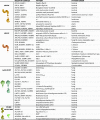Surface Sensor Systems in Plant Immunity
- PMID: 31822506
- PMCID: PMC7140916
- DOI: 10.1104/pp.19.01299
Surface Sensor Systems in Plant Immunity
Abstract
Protein complexes at the cell surface facilitate the detection of danger signals from diverse pathogens and initiate a series of complex intracellular signaling events that result in various immune responses.
Figures




References
-
- Albert I, Böhm H, Albert M, Feiler CE, Imkampe J, Wallmeroth N, Brancato C, Raaymakers TM, Oome S, Zhang H, et al. (2015) An RLP23–SOBIR1–BAK1 complex mediates NLP-triggered immunity. Nat Plants 1: 15140. - PubMed
-
- Albert I, Zhang L, Bemm H, Nürnberger T (2019) Structure-function analysis of immune receptor AtRLP23 with its ligand nlp20 and coreceptors AtSOBIR1 and AtBAK1. Mol Plant Microbe Interact 32: 1038–1046 - PubMed
-
- Albert M, Jehle AK, Lipschis M, Mueller K, Zeng Y, Felix G (2010) Regulation of cell behaviour by plant receptor kinases: Pattern recognition receptors as prototypical models. Eur J Cell Biol 89: 200–207 - PubMed
-
- Bar M, Sharfman M, Ron M, Avni A (2010) BAK1 is required for the attenuation of ethylene-inducing xylanase (Eix)-induced defense responses by the decoy receptor LeEix1. Plant J 63: 791–800 - PubMed
Publication types
MeSH terms
Substances
LinkOut - more resources
Full Text Sources
Other Literature Sources

